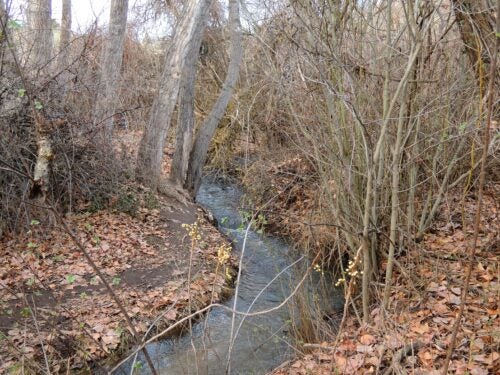
The city of Boise is hugged by foothills and is a short drive to both the desert and mountains, which is why recreation is a huge part of the city’s identity. This outdoor accessibility is invaluable but hard to quantify for many residents, not to mention regional and city planners who must balance growth and development with the preservation of our natural assets.
However, that soon could change. Boise State University researchers have created a novel new way of demonstrating the positive physiological effects nature can have on humans by measuring cortisol levels in their saliva. Cortisol is a steroid hormone that is released in response to stress, among other things.
“Julie Heath and I knew we wanted to study how humans make landscape use decisions in recreational contexts,” explained Kathryn Demps, an associate professor of anthropology.
Demps, along with Heath, a biology professor, and biology master’s student Ellie Opdahl, designed an experiment to test the cortisol levels in individuals’ saliva before and after hiking and biking in the Boise foothills. While a Japanese study previously tracked individuals’ cortisol levels before and after walking through a forest, Demps noted that this marked the first time that biological data has been collected to tie human stress levels to arid landscapes.

Between April-May 2017, Opdahl collected saliva samples from both hikers and mountain bikers four days per week between 9 a.m.-6:30 p.m. at the Camel’s Back Park Ridge to Rivers trailhead. Samples were collected from volunteers before and after recreating, and a survey also was administered after recreating. Cameras and GPS tracking devices were lent to participants, who were encouraged to snap photos of scenery they felt was particularly beautiful or calming. In addition, the fieldwork was conducted on both weekends and weekdays to try and gage any differences on the effects of outdoor recreation during crowded (weekend) and less crowded (weekday) times.
Their research was funded by a National Science Foundation grant, Managing Idaho’s Landscapes for Ecosystems Services (MILES) managed by Idaho EPSCoR.
Opdahl then analyzed the saliva samples in Heath’s lab, which has been set up to analyze stress levels in golden eagles.
The team has focused on interpreting data taken from participating hikers. In total, 88 hikers participated; there were 77 saliva samples, 63 surveys, 58 GPS tracks and 22 photographs.
“The GPS info tied to their biological data and survey data, and creates a very beautiful picture” that helps researchers better understand individuals’ perceptions of what they think is beautiful in nature and how they respond to it physiologically, Demps explained.

Outdoor recreation is understandably complex and impacts both human and natural systems. Despite this complexity, it is possible to find quantifiable relationships and trends: for one, the team found that people seem to be drawn to areas of high aesthetic quality – namely, riparian areas like streams and the banks of rivers. These areas were characterized as areas of biological stress relievers for recreationists, and also include higher biodiversity, presence of wildlife and complex vegetation.
“As more people are choosing to recreate in these types of habitats, however, wildlife may become displaced as wildlife presence decreases with higher visitor use,” Opdahl explained. “The loss of wildlife and biodiversity may, in the future, make these areas less desirable for recreation, thereby decreasing their ecological and sociological value.”
Thanks to the team’s survey “we can already begin to pinpoint areas of future concern where management actions should be delivered to preserve the ecological integrity of riparian areas for both wildlife and humans alike,” Opdahl said.
“The main result is that there was a decrease in cortisol, in general, to all the hikers, but cortisol decreased the most in those who hiked through riparian biodiverse habitats. There’s something about this biodiverse landscape that is tied to stress decreases,” said Demps. “That’s good news; it means that conservation goals and human well-being goals are very closely tied. But it’s bad news in that people want to be in the places that should be preserved – and then they impact those spaces.”
The team has submitted their findings to Science magazine.
Their long-term goal is to expand the survey into a complete human environment systems analysis that maps human activity and human responses, as well as animal activity and animal responses, to a set environmental area. This would create a large-scale stress landscape.
“To me, a big gap that we are still facing in the sciences is a lack of communication across different disciplines, and I think that is especially prevalent in conservation biology which straddles both the human and natural systems,” Opdahl said. “I think holistic approaches to environmental issues are necessary for effective management, and to do that, we truly need interdisciplinary work. That said, having advisors in both biology and anthropology, and being able to conduct research that focused on both the social and ecological systems was my favorite aspect of this project.”